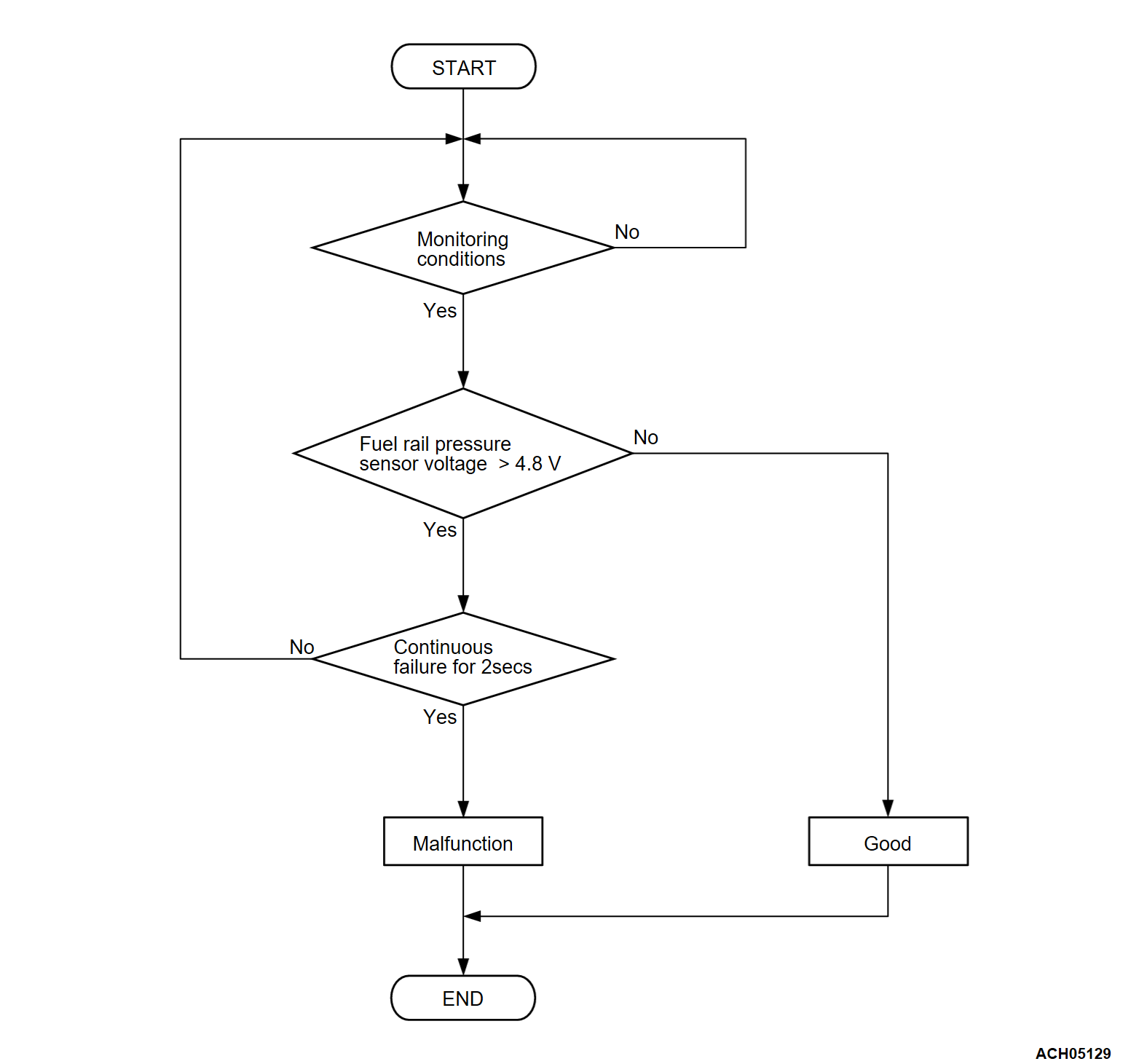DTC P0193: Fuel Rail Pressure Circuit High Input
CIRCUIT OPERATION
- A 5-volts voltage is supplied to the fuel rail pressure sensor power terminal from the ECM terminal HFP5. The ground terminal is grounded with ECM terminal HFPG.
- The sensor signal is inputted to the ECM connector terminal HFPS from the fuel rail pressure sensor output terminal.
TECHNICAL DESCRIPTION
The fuel rail pressure sensor detects a change in fuel pressure and inputs the signal to the ECM.
DESCRIPTIONS OF MONITOR METHODS
- Fuel rail pressure sensor output voltage is out of specified range.
MONITOR EXECUTION
- Continuous
MONITOR EXECUTION CONDITIONS (Other monitor and Sensor)
Other Monitor (There is no temporary DTC set in memory for the item monitored below)
- Not applicable
Sensor (The sensor below is determined to be normal)
- Not applicable
DTC SET CONDITIONS
Check Conditions
- 2 seconds or more have passed since the engine starting sequence was completed.
- Battery positive voltage is higher than 6 volts.
Judgment Criterion
- Fuel rail pressure sensor output voltage is more than 4.8 volts for 2 seconds.
FAIL-SAFE AND BACKUP FUNCTION
- While prohibiting the operation of the injector (high pressure), carry out the control by the injector operation only.
- Torque is restricted.
TROUBLESHOOTING HINTS (The most likely causes for this code to be set are:)
- Fuel rail pressure sensor failed.
- Open fuel rail pressure sensor circuit, or connector damage.
- ECM failed.
DIAGNOSIS
STEP 1. Using scan tool (M.U.T.-IIISE), check data list item 124: Fuel Rail Pressure Sensor (Absolute)
| caution | To prevent damage to scan tool (M.U.T.-IIISE), always turn the ignition switch to the "LOCK" (OFF) position before connecting or disconnecting scan tool (M.U.T.-IIISE). |
(2) Start the engine.
(3) Set scan tool (M.U.T.-IIISE) to the data reading mode for item 124, Fuel Rail Pressure Sensor (Absolute).
(4) Warm up the engine.
- When the engine is idling, 4,000 - 21,000 kPa (1,181.4 - 6,202.0 in.Hg).
(5) Turn the ignition switch to the "LOCK" (OFF) position.
Is the sensor operating properly?
STEP 2. Measure the voltage at fuel rail pressure sensor connector.
(1) Disconnect the connector and measure at the harness side.
(2) Turn the ignition switch to the "ON" position.
(3) Measure the voltage between terminal HFPS line and ground.
- Voltage should be between 4.9 and 5.1 volts.
(4) Turn the ignition switch to the "LOCK" (OFF) position.
Is the measured voltage between 4.9 and 5.1 volts?
STEP 3. Check of open circuit in HFPS line between fuel rail pressure sensor connector and ECM connector.
Is the harness wire in good condition?
STEP 4. Using scan tool (M.U.T.-IIISE), check data list item 124: Fuel Rail Pressure Sensor (Absolute)
(1) Start the engine.
(2) Set scan tool (M.U.T.-IIISE) to the data reading mode for item 124, Fuel Rail Pressure Sensor (Absolute).
(3) Warm up the engine.
- When the engine is idling, 4,000 - 21,000 kPa (1,181.4 - 6,202.0 in.Hg).
(4) Turn the ignition switch to the "LOCK" (OFF) position.
Is the sensor operating properly?
STEP 5. Measure the resistance at fuel rail pressure sensor connector.
(1) Disconnect the connector and measure at the harness side.
(2) Measure the resistance between terminal HFPG line and ground.
- Continuity (2 ohms or less)
Does continuity exist?
STEP 6. Check of open circuit and harness damage in HFPG line between fuel rail pressure sensor connector and ECM connector.
Is the harness wire in good condition?
STEP 7. Using scan tool (M.U.T.-IIISE), check data list item 124: Fuel Rail Pressure Sensor (Absolute)
(1) Start the engine.
(2) Set scan tool (M.U.T.-IIISE) to the data reading mode for item 124, Fuel Rail Pressure Sensor (Absolute).
(3) Warm up the engine.
- When the engine is idling, 4,000 - 21,000 kPa (1,181.4 - 6,202.0 in.Hg).
(4) Turn the ignition switch to the "LOCK" (OFF) position.
Is the sensor operating properly?
STEP 8. Replace the fuel rail (high pressure) (integrated with fuel rail pressure sensor).
(1) Replace the fuel rail (high pressure) (integrated with fuel rail pressure sensor).
(2) Carry out a test drive with the drive cycle pattern. Refer to Diagnostic Function - OBD-II Drive Cycle - Pattern 1  .
.
 .
.(3) Check the diagnostic trouble code (DTC).
Is DTC P0193 set?
 The inspection is complete.
The inspection is complete.![[Previous]](../../../buttons/fprev.png)
![[Next]](../../../buttons/fnext.png)

